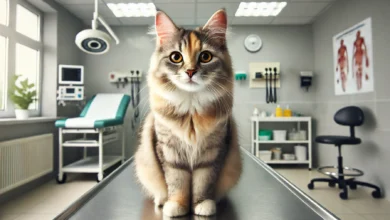How to Treat Flea Allergies in Cats Effectively

Flea allergy dermatitis is one of the more testing problems that most pet owners face with their cats.
The fact that your cat is continuously scratching or even biting in discomfort, or over-grooming, may indicate the possibility of flea allergies.
A flea allergy occurs when the cat’s immune system reacts to the saliva of fleas.
This triggers skin irritation along with other unpleasant symptoms.
If left untreated, flea allergies can cause serious discomfort, infections, and long-term health problems in cats.
In this article, we will discuss how to identify and manage flea allergies in cats, along with appropriate treatment options to keep your cat happy and healthy.
Knowing what causes flea allergies and how they affect your cat is key to managing the condition.
So, let’s start by looking into the source of the problem and the more typical symptoms you might notice in your pet.
Table of Contents
Understanding Feline Flea Allergies
Flea allergies in cats are caused by an allergic reaction to the proteins contained in flea saliva.
When a flea bites your cat, it deposits some saliva into the skin, triggering an allergic reaction.
Even just a few bites can cause significant discomfort to a cat with flea allergies, making immediate attention necessary when symptoms appear.
Flea allergies can occur at any point in a cat’s life, even if the cat has never had issues with fleas before.
Some cats may develop an allergy after several flea bites, while others may experience symptoms after just one bite.
This allergic reaction leads to intense itching, redness, and inflammation.
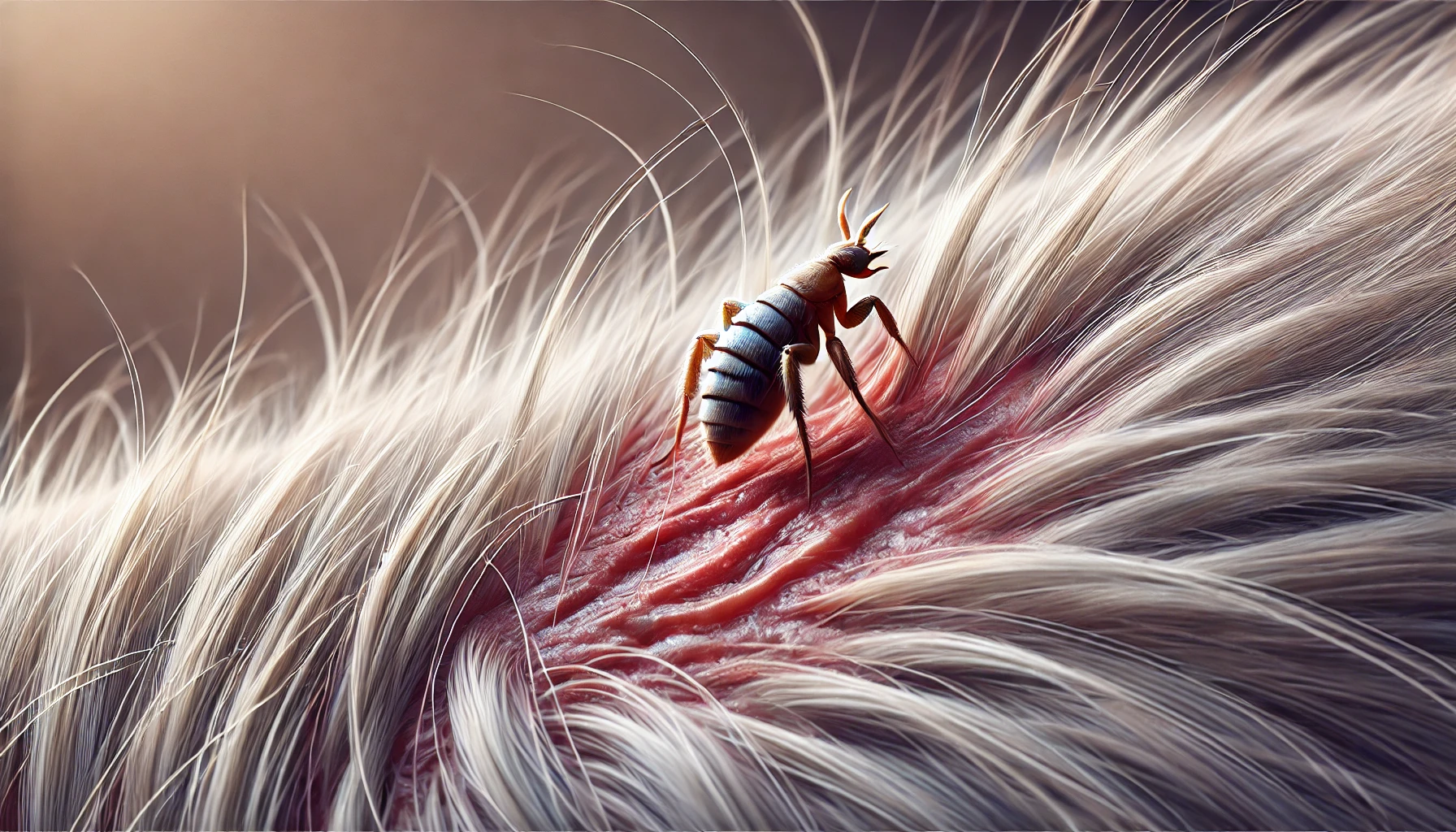
What Is the Cause of Flea Allergies?
The main cause of flea allergies in cats is the reaction to flea saliva.
A flea bite might seem harmless, but it delivers proteins that the immune system overreacts to.
Fleas are small parasites that feed on the blood of mammals, and their bites become problematic when a cat’s immune system detects the saliva and triggers an allergic reaction.
- With each feeding, fleas deposit saliva into the skin, which is the source of the allergic reaction in sensitive cats.
- Cats can develop flea allergies after repeated exposure to fleas or bites.
- Even indoor cats are at risk if fleas enter the home through another pet or the environment.

Common Symptoms of Flea Allergies
Early identification of flea allergy symptoms is necessary to minimize your cat’s discomfort.
Cats often react to flea allergies by excessively scratching, biting, or licking their skin.
You may also notice hair loss, scabs, or irritated skin areas.
Some of the common symptoms to watch for include:
- Excessive itching and scratching, primarily on the neck, back, and base of the tail.
- Redness or small bumps on the skin that may become infected.
- Excessive grooming to the extent of causing bald spots or thinning fur.
- Scabs or sores from chronic scratching or biting.
- Restlessness and irritation, which may worsen after flea exposure.
Flea allergies in cats can be easily misdiagnosed, but recognizing them early can save your feline friend from discomfort.
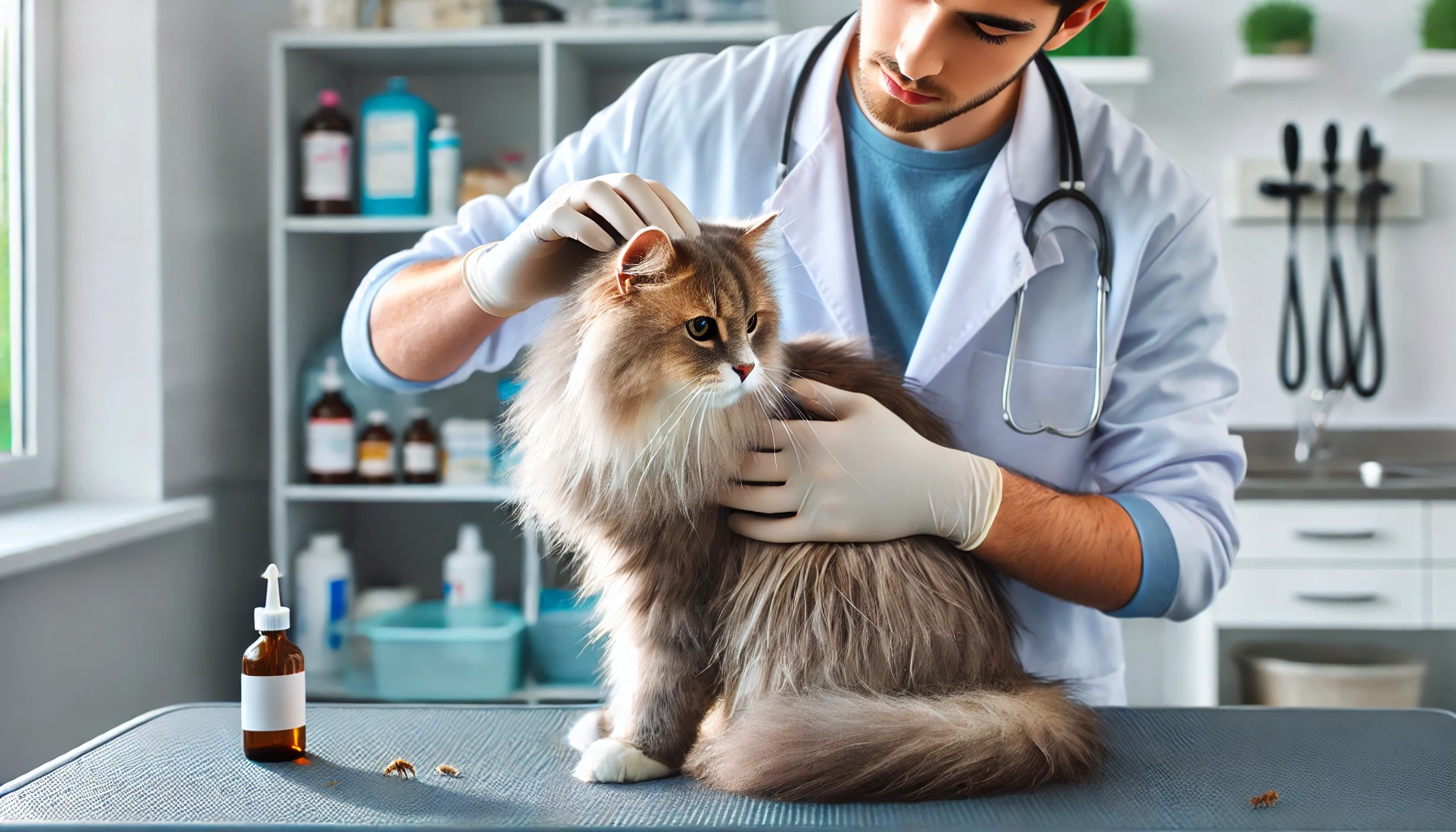
Diagnosing Flea Allergies in Cats
Diagnosis of flea allergies in cats is the key to proper treatment for your cat.
The signs and symptoms of flea allergic dermatitis can sometimes appear similar to other skin conditions; therefore, determining the exact cause is vital for the correct care.
If you suspect that your cat has a flea allergy, it is critical that you consult with a veterinarian for a proper diagnosis.
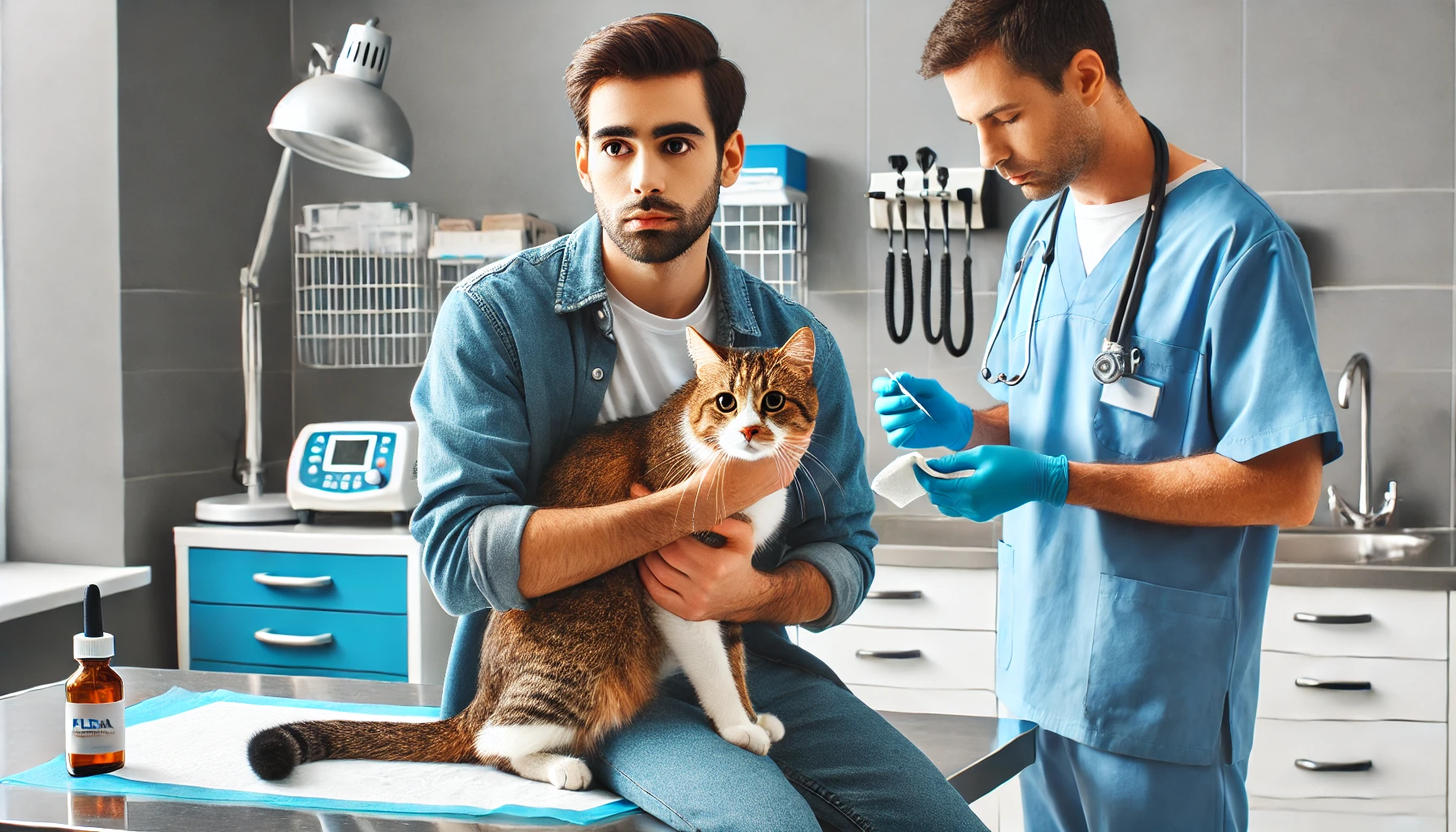
When to Seek Veterinary Care
If your cat continually scratches at its skin, if hair loss occurs, or if the skin becomes red and inflamed, a veterinary checkup is necessary.
Some owners may try home remedies; however, early veterinary treatment is best since neglected flea allergies can lead to secondary infections and other health issues.
Your veterinarian will provide a thorough examination and go over the history of your cat’s symptoms in order to determine the probability of flea allergy dermatitis.
In some cases, the veterinarian may prescribe a trial of flea control medication to rule out flea allergies as the source.
While the presence of fleas or flea dirt on your cat may help with diagnosis, a suspected flea allergy may arise even in the absence of these findings.
This is because some cats can exhibit an allergic reaction from just one flea bite, and signs of fleas may not always be visible.
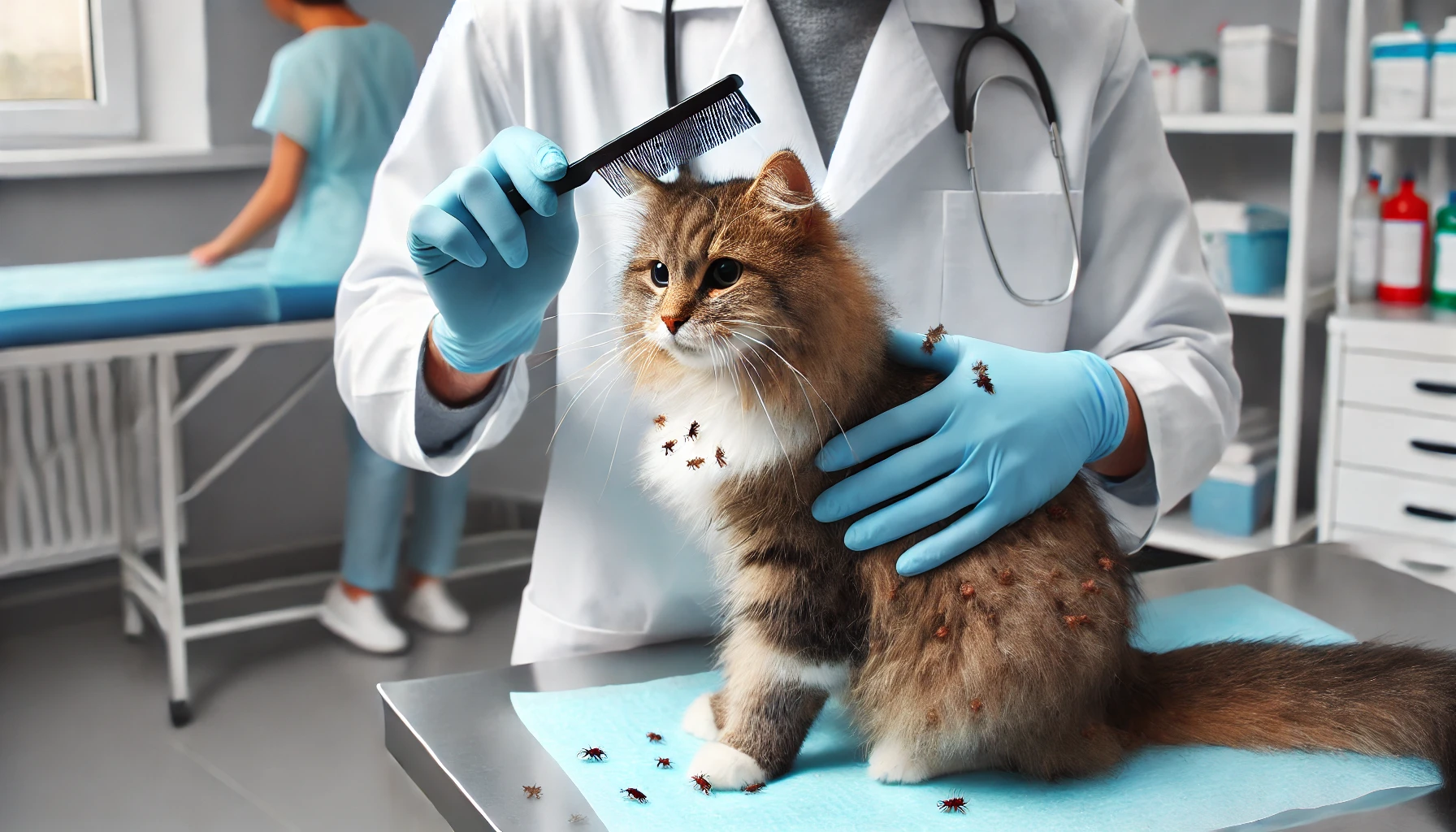
Tests Confirming Flea Allergy
Here are a few diagnostic tests a veterinarian could employ to confirm flea allergies in your cat:
- Flea dirt test: A veterinarian can comb your cat’s fur and look for flea dirt, which appears as small black specks. If present, it likely means your cat had recent exposure to fleas.
- Skin scrapings: The vet may take a small skin sample from your cat to check for mites or other parasites that might show similar symptoms.
- Intradermal skin testing: For this test, small amounts of flea allergens are injected into the skin to observe if your cat reacts with an allergic response. This is one of the most reliable methods for confirming flea allergies.
- Blood tests: Some veterinarians perform blood tests to detect antibodies against flea allergens circulating in the blood.
Accurate diagnosis is important in managing your cat’s discomfort and preventing long-term problems.
Once the diagnosis of flea allergies has been confirmed, your veterinarian will discuss a treatment plan most appropriate for your cat.
Early diagnosis is essential in preventing secondary infections and complications in cats with flea allergies.
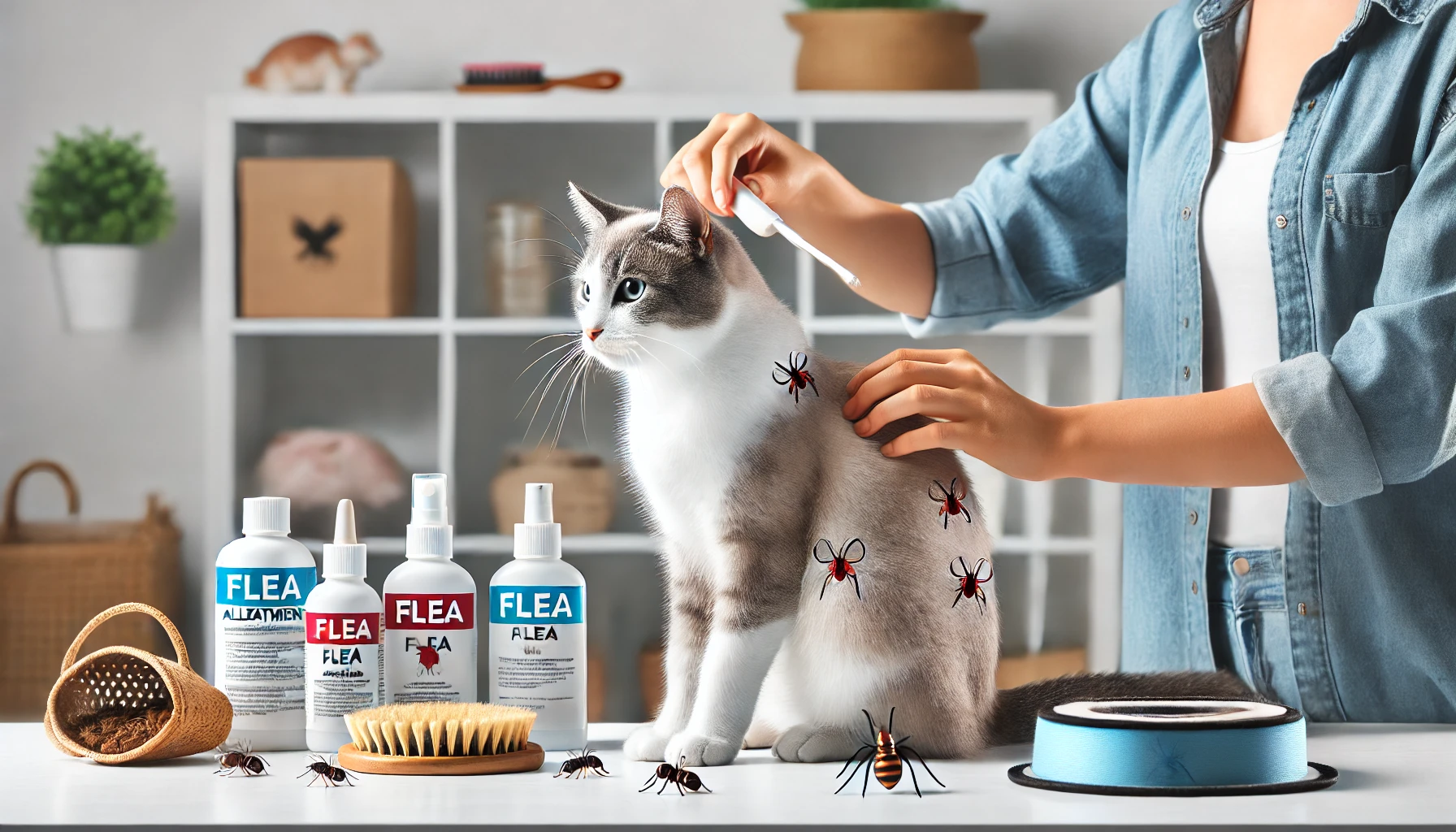
Treatment Options for Flea Allergies
Once your cat has been diagnosed with flea allergies, treatment should follow quickly to alleviate the discomfort and prevent further complications.
The treatment aims to eradicate fleas and manage the allergic reaction your cat is experiencing.
Treatment options vary from medications to natural remedies, depending on the severity of your cat’s flea allergies and overall health.
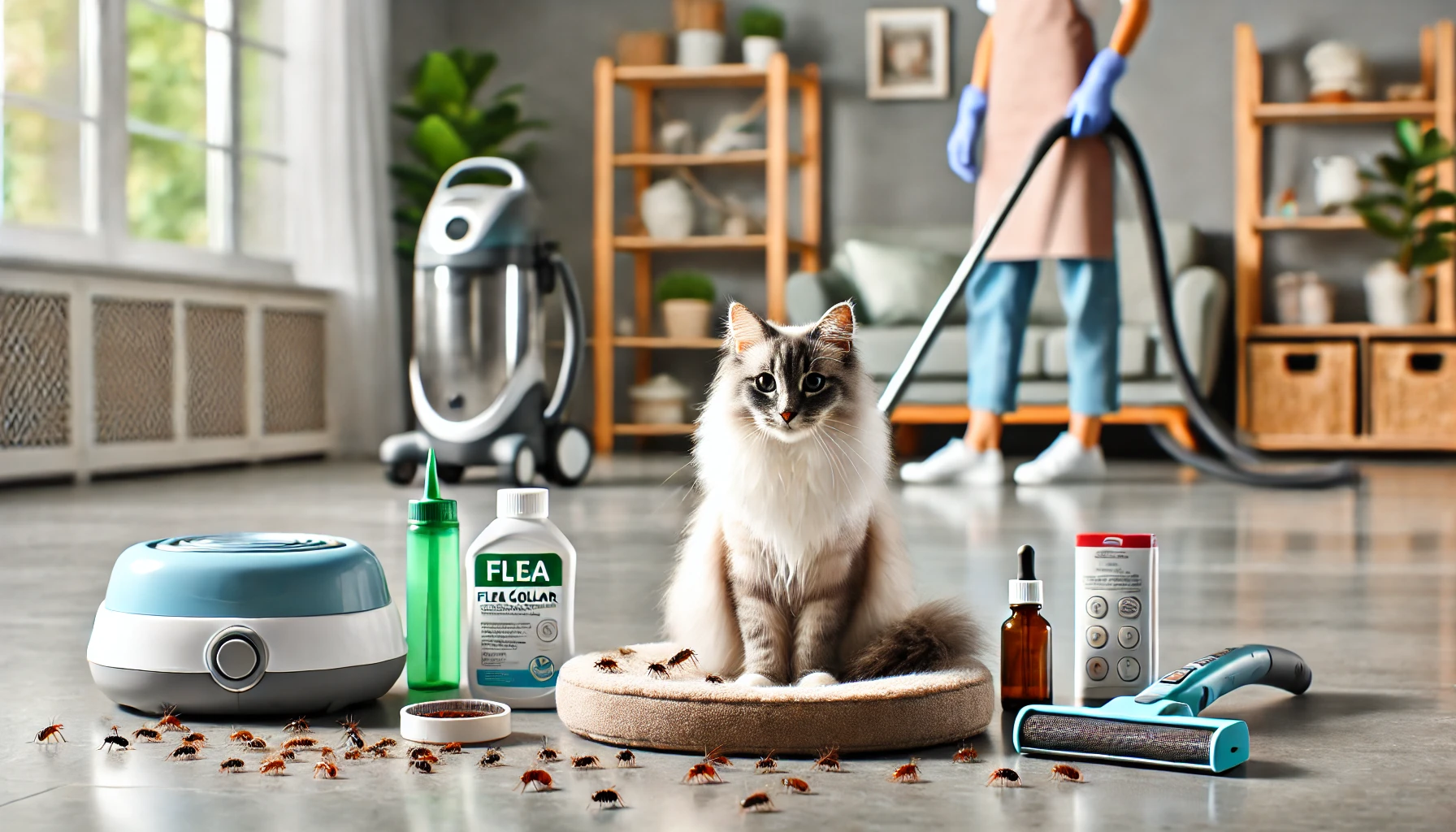
Flea Prevention and Control
The first and most important step in treating flea allergies is eliminating the fleas from your cat and its environment.
This can be done using various flea control methods:
- Topical treatments: These are applied directly to your cat’s skin and provide long-lasting protection. Examples include Advantage, Frontline, and Revolution. These medications kill fleas upon contact and prevent re-infestation.
- Flea pills: Flea pills, like Capstar or Comfortis, kill fleas quickly. They are often used alongside topical treatments to offer faster relief.
- Flea collars: These collars gradually release chemicals that kill fleas and offer protection for an extended period, lasting up to 8 months.
- Environmental control: In addition to treating your cat, it’s important to clean your home. Vacuum carpets, rugs, and upholstery to remove fleas, eggs, and larvae. Wash your cat’s bedding and soft furnishings in hot water to eliminate any remaining fleas.
Ensuring that your cat’s surroundings are flea-free is key to preventing future allergic reactions.
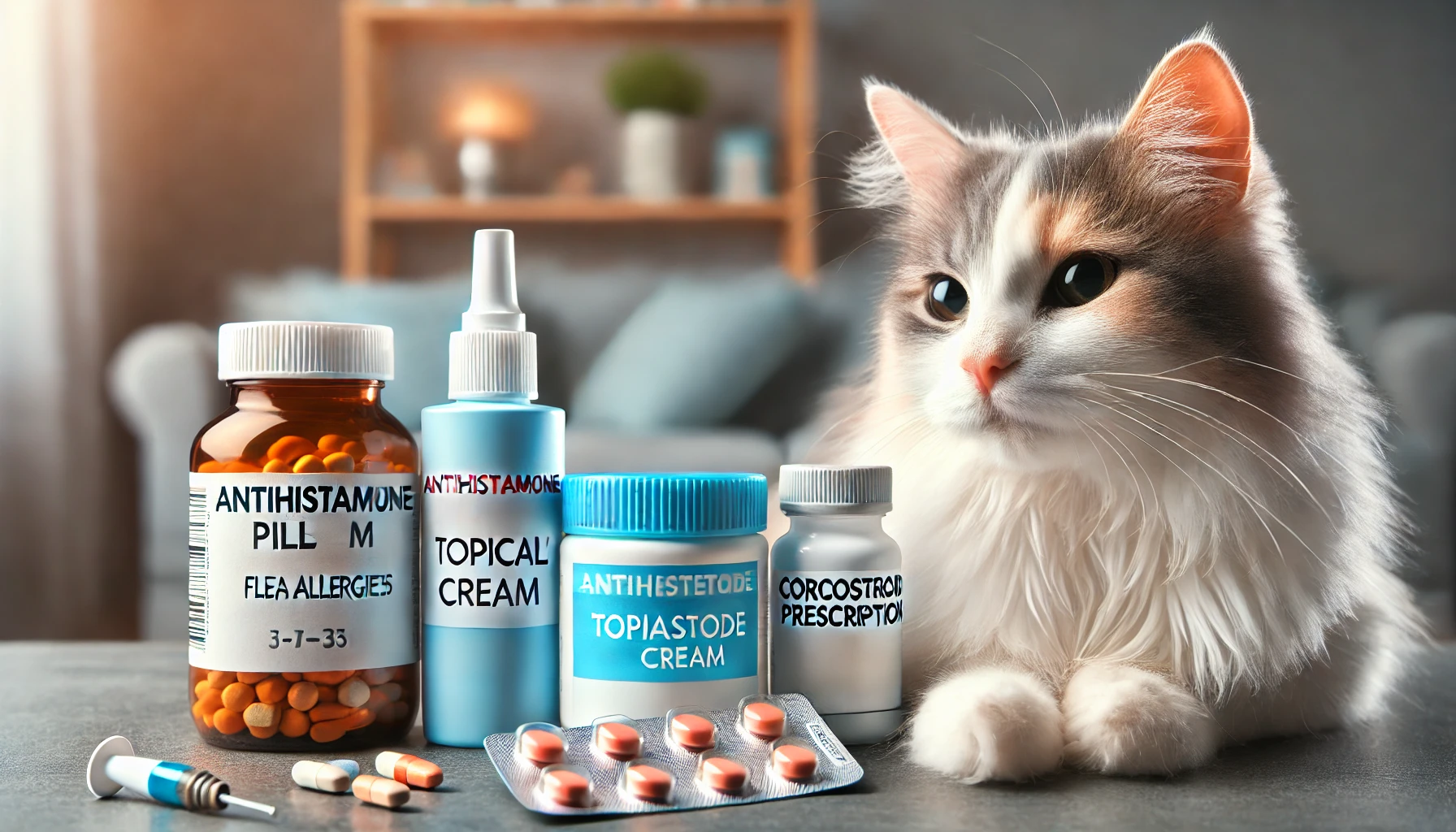
Symptom Reliever Medications
Even after fleas are gone, your cat may still suffer from the allergic reaction.
Medications can help relieve itching and inflammation related to flea allergies.
Common treatments include:
- Antihistamines: These are prescribed to provide relief from itching and discomfort. Your vet will recommend an antihistamine based on your cat’s condition.
- Steroids: For severe cases, your veterinarian may recommend corticosteroids to alleviate inflammation and itching caused by flea allergy dermatitis. Steroids are typically prescribed for short-term use due to potential side effects.
- Antibiotics: If secondary infections occur from scratching or biting, antibiotics may be prescribed to treat bacterial infections.
- Omega-3 supplements: Omega-3 fatty acids help reduce inflammation and promote healthier skin, making them a beneficial addition to your cat’s treatment plan.

Natural Treatments for Flea Allergies
For those seeking alternative treatments, there are natural remedies available to help manage flea allergies.
These should be used alongside traditional treatments and with your veterinarian’s approval:
- Aloe vera gel: Aloe vera has soothing properties and can be applied topically to reduce itching and promote healing of inflamed skin.
- Oatmeal baths: Oatmeal baths are excellent for soothing inflamed skin and reducing itchiness. Oatmeal-based shampoos are available at most pet stores for cats with sensitive skin.
- Apple cider vinegar: Diluted apple cider vinegar can help repel fleas and soothe skin irritations when applied to your cat’s fur.
While these natural remedies may alleviate symptoms, it’s important to monitor your cat closely and ensure their flea allergies are being effectively managed.
Treatment plans should target both flea elimination and symptom management to bring relief to your cat.
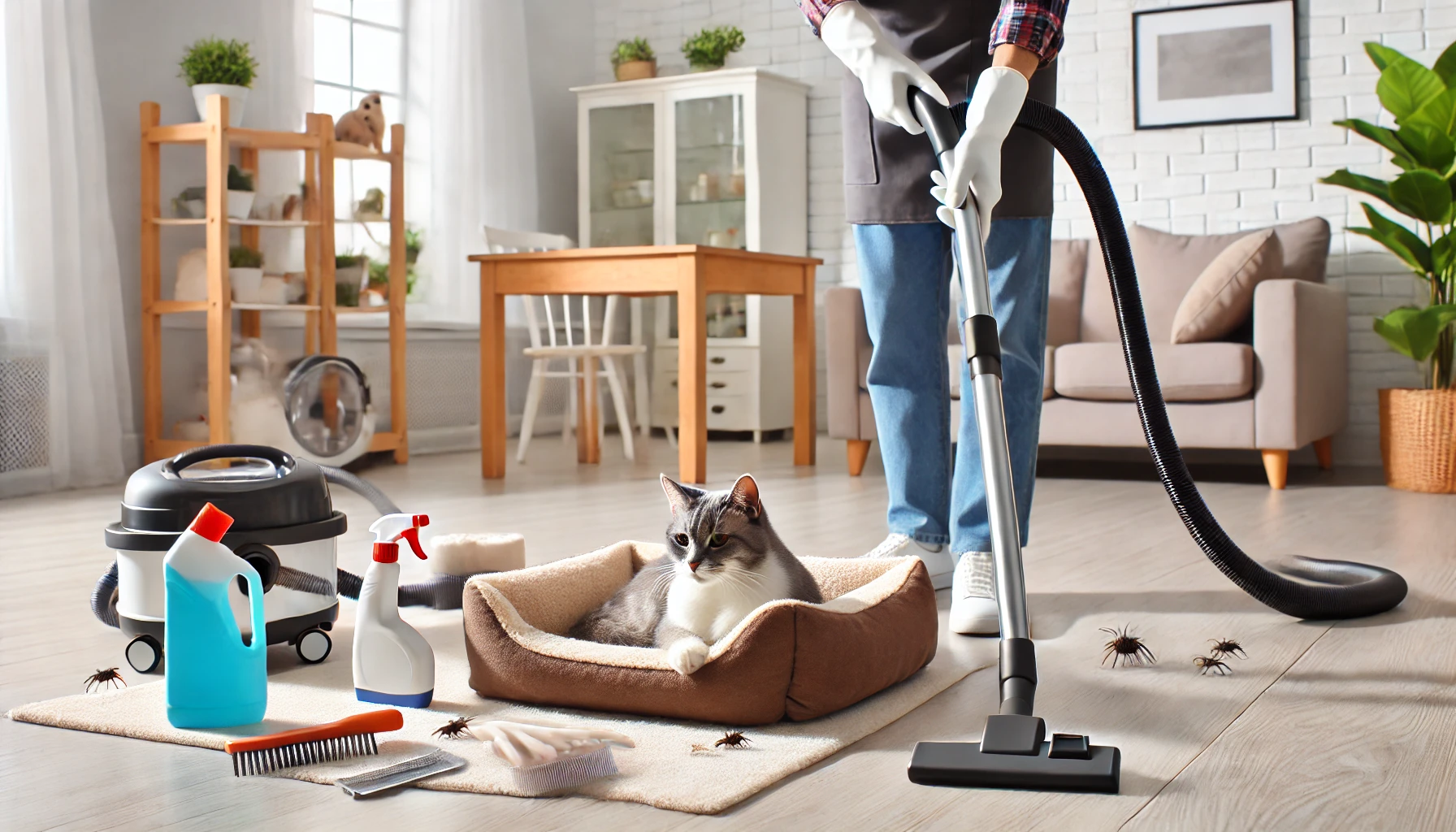
Controlling Flea Allergies at Home
Controlling flea allergies at home is vital to ensuring that your feline stays comfortable and free from further allergic attacks.
While medications and flea control treatments are crucial, maintaining a clean, flea-free environment contributes significantly to avoiding re-infestation.
Regular grooming and care for your cat also help manage symptoms and aid in recovery from flea allergies.
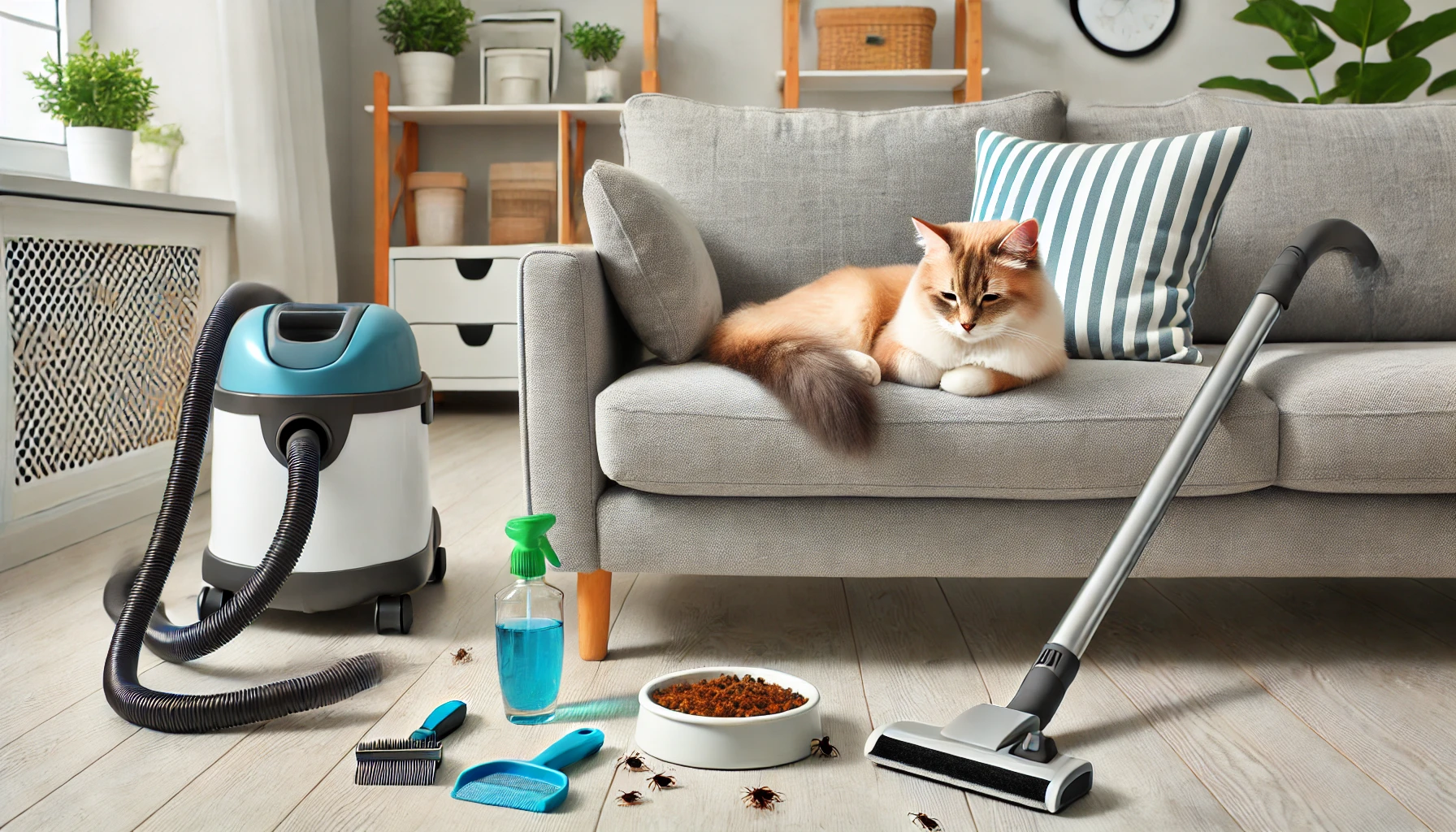
Keeping Your Home Flea-Free
A key aspect of managing flea allergies is ensuring that your home is completely free of fleas.
Fleas may hide in carpets, bedding, and upholstery, and if not properly addressed, this can lead to re-infestation.
Here’s how to keep your home flea-free:
- Regular vacuuming: Vacuum your home frequently, especially in areas where your cat spends the most time, such as carpets, rugs, and furniture. Vacuuming helps remove fleas, eggs, and larvae hidden deep in the fabric.
- Washing bedding: Wash your cat’s bedding, blankets, and any soft furnishings in very hot water to eliminate fleas and prevent infestation. Washing should be done once a week to maintain a fresh and flea-free environment.
- Flea sprays and treatments: Use flea sprays or environmental treatments designed for the home to kill any fleas that may be hiding in cracks and crevices. Make sure to use only pet-safe products recommended by your veterinarian.
- Outdoor care: If your cat spends time outdoors, ensure your yard is well-maintained. Keep grass and bushes trimmed, as fleas thrive in tall grass. Maintaining a tidy yard reduces the chance of fleas entering your home.
Keeping the environment clean and free from fleas is the most effective preventive measure against recurring flea allergies.
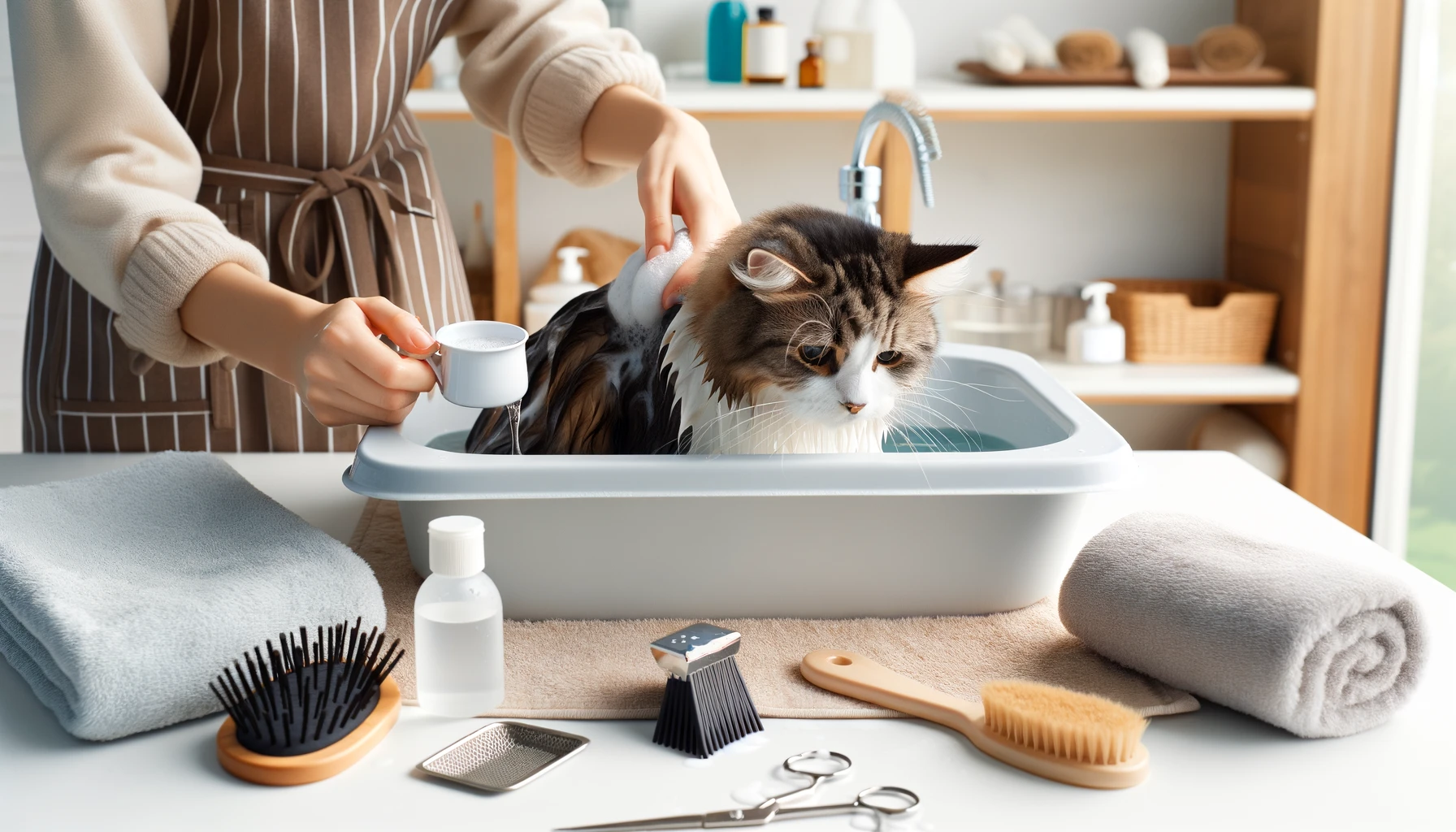
Bathing and Grooming Tips for Cats with Allergies
Regular bathing and grooming are essential for managing your cat’s flea allergies.
Bathing helps remove any remaining fleas and soothes irritated skin, while grooming prevents further itching and discomfort.
- Bathing your cat: Bathe your cat using a flea shampoo recommended by your veterinarian or a hypoallergenic shampoo. Flea shampoos remove fleas, while hypoallergenic shampoos help heal the skin and reduce irritation caused by flea allergies. Avoid over-bathing, as it can dry out your cat’s skin and worsen the problem.
- Regular brushing: Regular brushing helps remove fleas and flea dirt from your cat’s coat, stimulates the skin, and promotes healthy fur growth. Use a flea comb to locate and remove fleas hidden deep in the coat.
- Paw and ear care: Fleas often hide in the crevices of your cat’s paws and ears. Pay special attention to these areas during grooming and clean them thoroughly to prevent fleas from causing further discomfort.
By maintaining regular grooming routines and keeping your home clean, you can significantly reduce flea allergy symptoms and keep your feline friend more comfortable.
Maintaining a clean, flea-free environment is the key to controlling your cat’s flea allergies effectively.
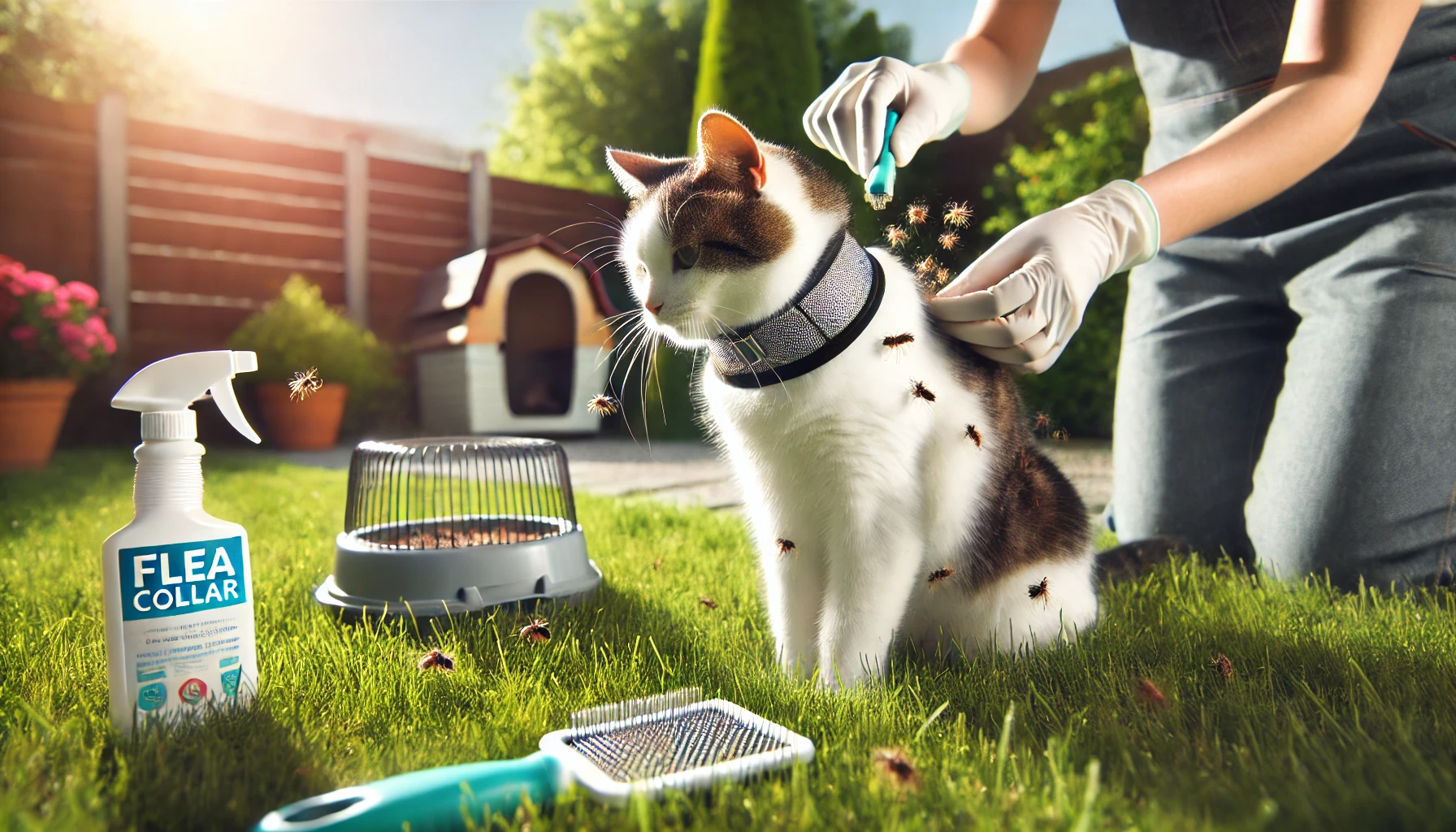
Preventing Future Flea Infestations
After successfully treating your cat for flea allergies, it is important to take measures to prevent future flea infestations.
This not only prevents further allergic reactions but also helps keep your cat healthy and comfortable.
Fortunately, there are several effective flea prevention methods that can be used year-round.
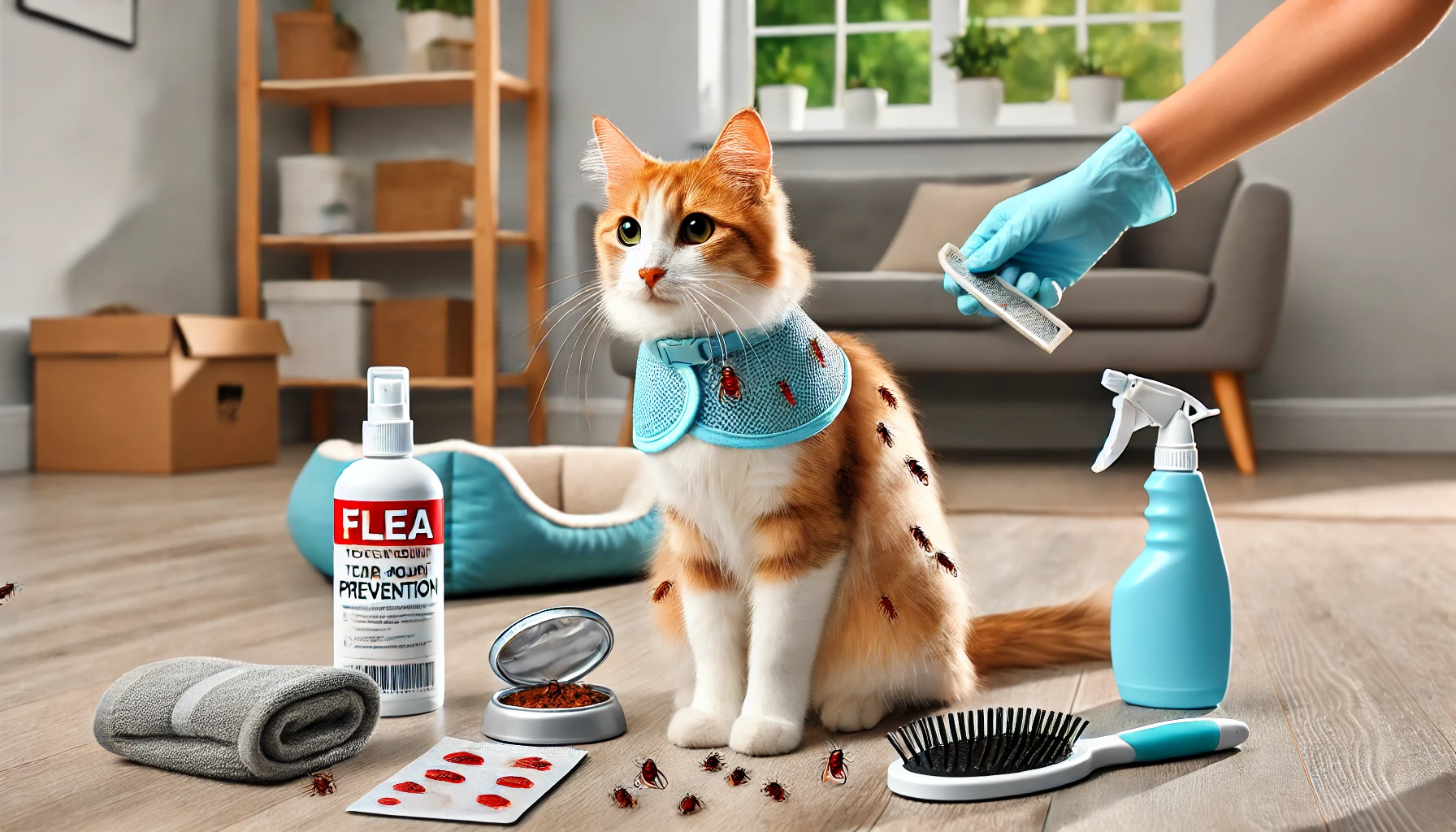
Year-Round Flea Prevention Strategies
Flea prevention is an ongoing process, as fleas can thrive in almost any climate and can affect indoor cats just as easily as outdoor ones.
Here are some methods to help prevent fleas from returning:
- Topical and oral treatments: These include topical applications or oral medications recommended by your veterinarian. Regular use can ensure year-round protection for your cat. Medications like Revolution or Comfortis are designed to kill fleas on contact, preventing re-infestation and keeping your cat protected.
- Flea collars: Flea collars, like Seresto, release small amounts of chemicals over a long period, repelling fleas. These are particularly useful for cats that spend time outdoors.
- Home environment management: Regular cleaning and vacuuming of carpets, bedding, and furniture can help remove flea eggs, larvae, and pupae before they develop into adult fleas. Flea sprays and environmental treatments can also help prevent flea development.
- Regular grooming: Regular grooming sessions, especially using a flea comb, can help detect fleas early and prevent further infestation. Grooming also reduces the likelihood of re-infestation by keeping your cat’s coat clean and healthy.
- Yard maintenance: For outdoor cats, keeping your yard well-trimmed and free of tall grass and debris helps limit the chance of fleas entering your home. Use yard treatments or sprays that target fleas, but ensure they are pet-safe.
By following these flea prevention strategies, you can protect your cat from further flea allergies and improve their overall well-being in the long term.
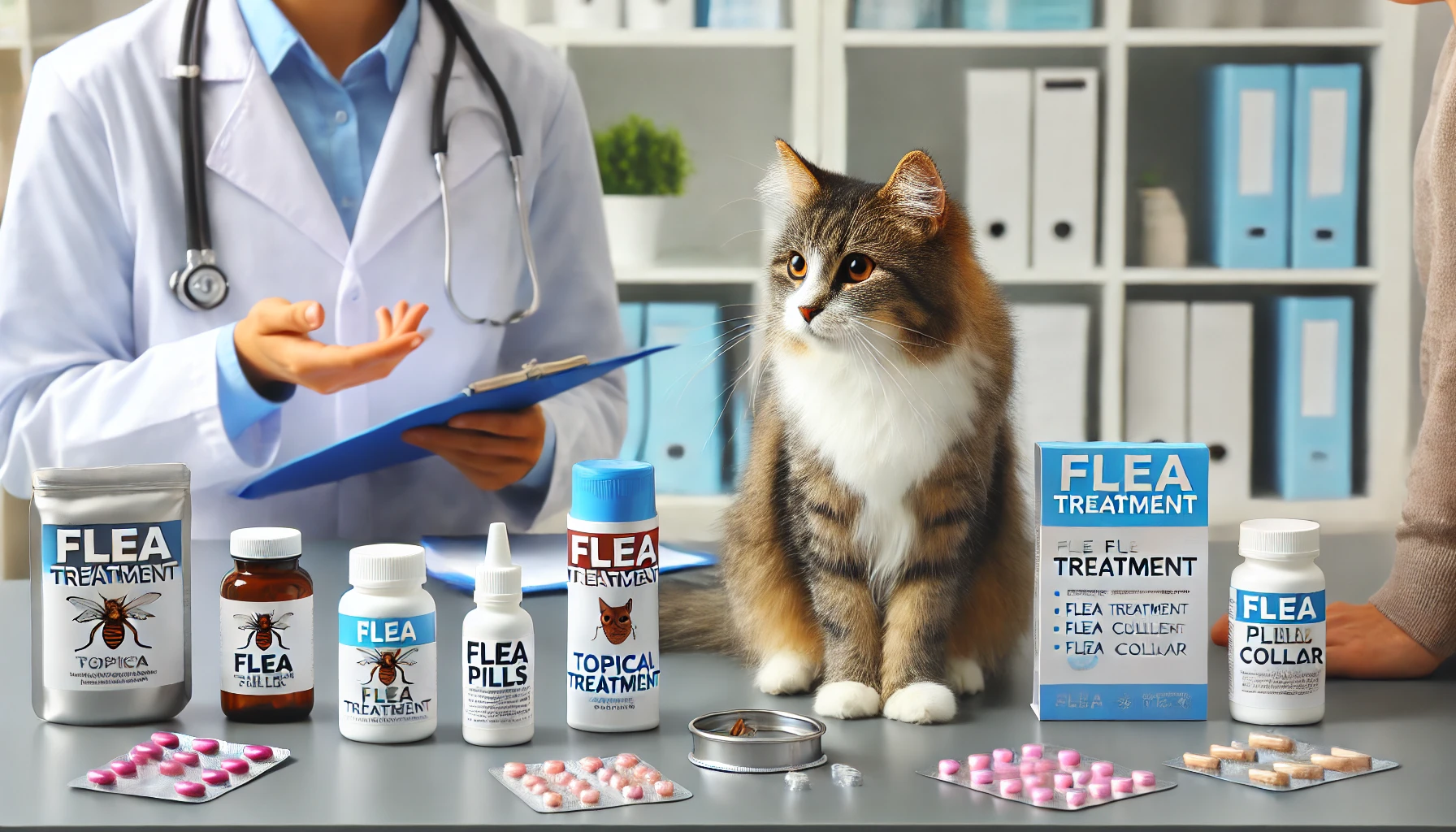
Finding the Correct Flea Treatment for Your Cat
Selecting the right flea prevention product is crucial, as your cat’s age, health, lifestyle, and whether they go outdoors will determine which treatment is most suitable.
- Consult your veterinarian: Always consult your vet before starting any flea prevention regimen. Your veterinarian can recommend the best products based on your cat’s health, as well as any allergies or sensitivities they may have.
- Consider your cat’s lifestyle: Indoor cats may require less potent flea prevention than outdoor cats, which are exposed to fleas more frequently. Your veterinarian can help you choose the right treatment based on your cat’s level of risk.
- Watch for side effects: After applying any flea treatment, monitor your cat for side effects such as lethargy, vomiting, or skin irritation. If any adverse reactions occur, consult your veterinarian immediately.
With the proper flea prevention therapy and a year-round prevention plan, you can keep your cat in optimal health and avoid future flea allergies.
Year-round flea prevention strategies such as regular grooming and topical treatments can help keep fleas at bay.
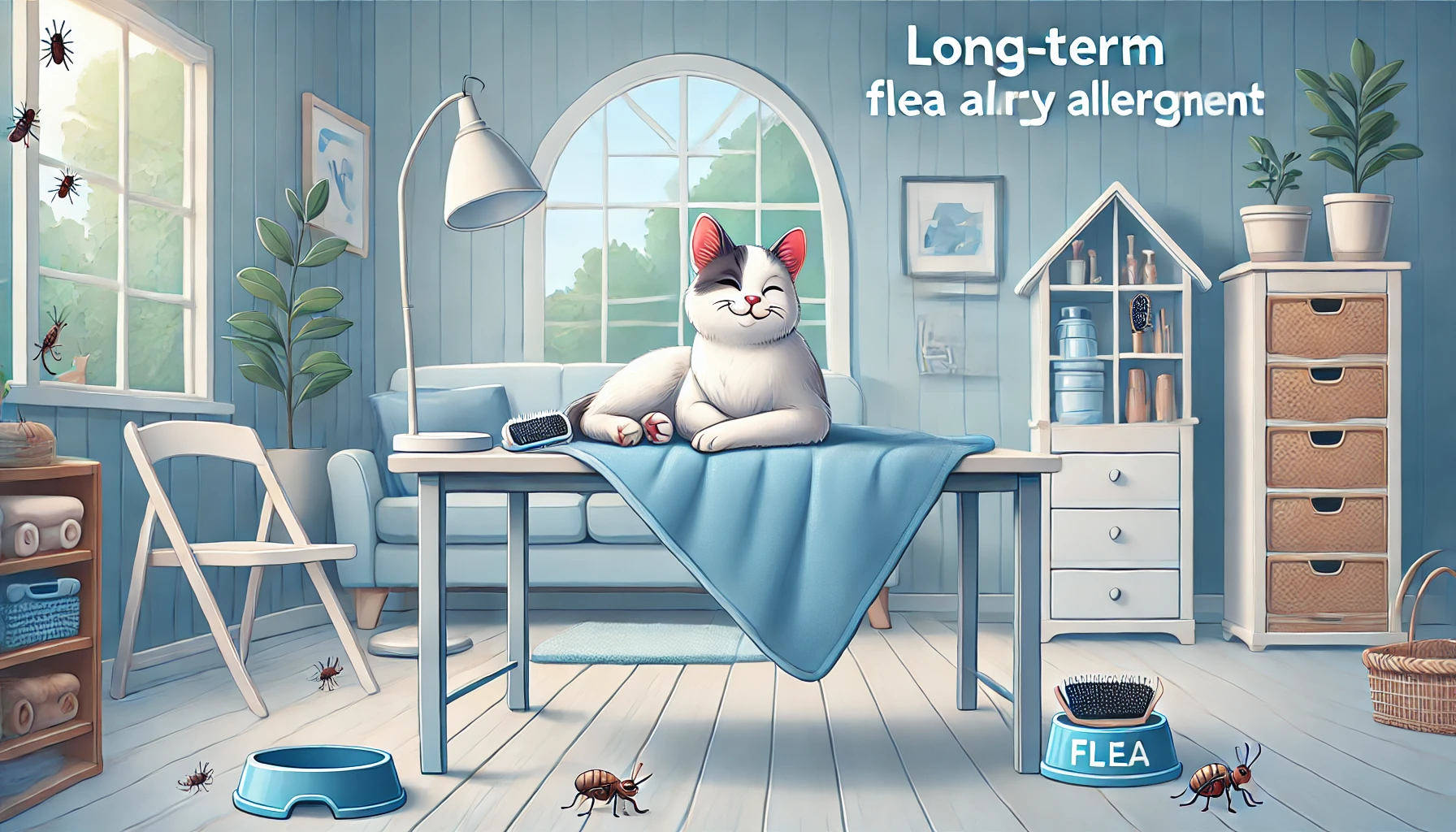
Ensuring Long-Term Relief from Flea Allergies in Cats
For many cats, flea allergies can be insidious, causing discomfort to their skin and irritation, potentially leading to health complications that might last for years if not treated in time.
By ensuring proper diagnosis, treatment, and preventive measures, you can keep your cat healthy and free from the agonies caused by flea allergies.
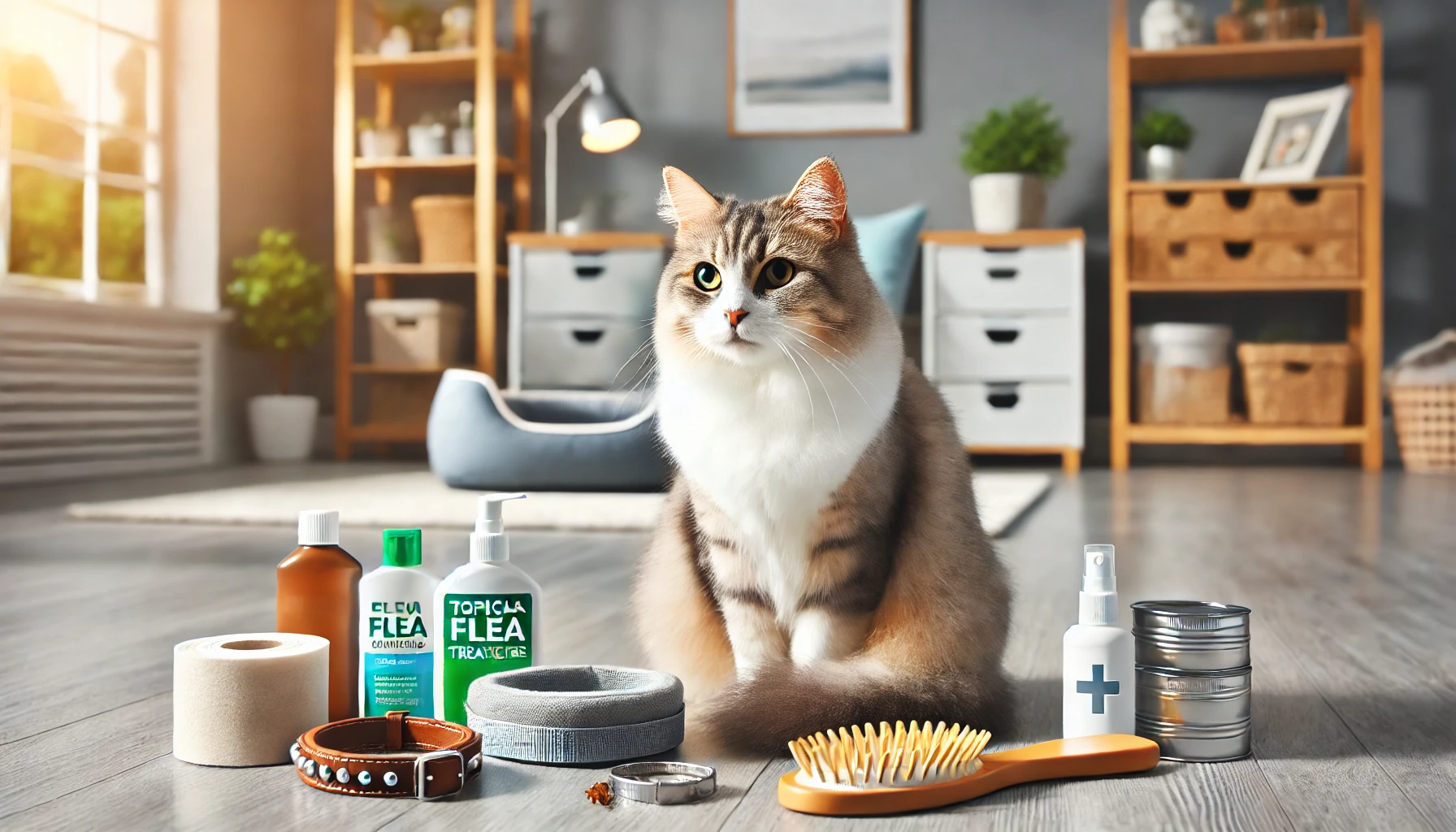
Key Takeaways for Managing Flea Allergies
The journey to managing flea allergies starts with understanding the root cause and ensuring your cat gets the right diagnosis.
Recognizing early symptoms and seeking veterinary care is a critical first step in providing relief for your feline companion.
Treatment varies, but with effective flea control and symptom management, your cat will feel comfortable.
Whether you opt for topical treatments, oral medications, or natural remedies, the focus should be on both killing fleas and soothing your cat’s allergic reaction.
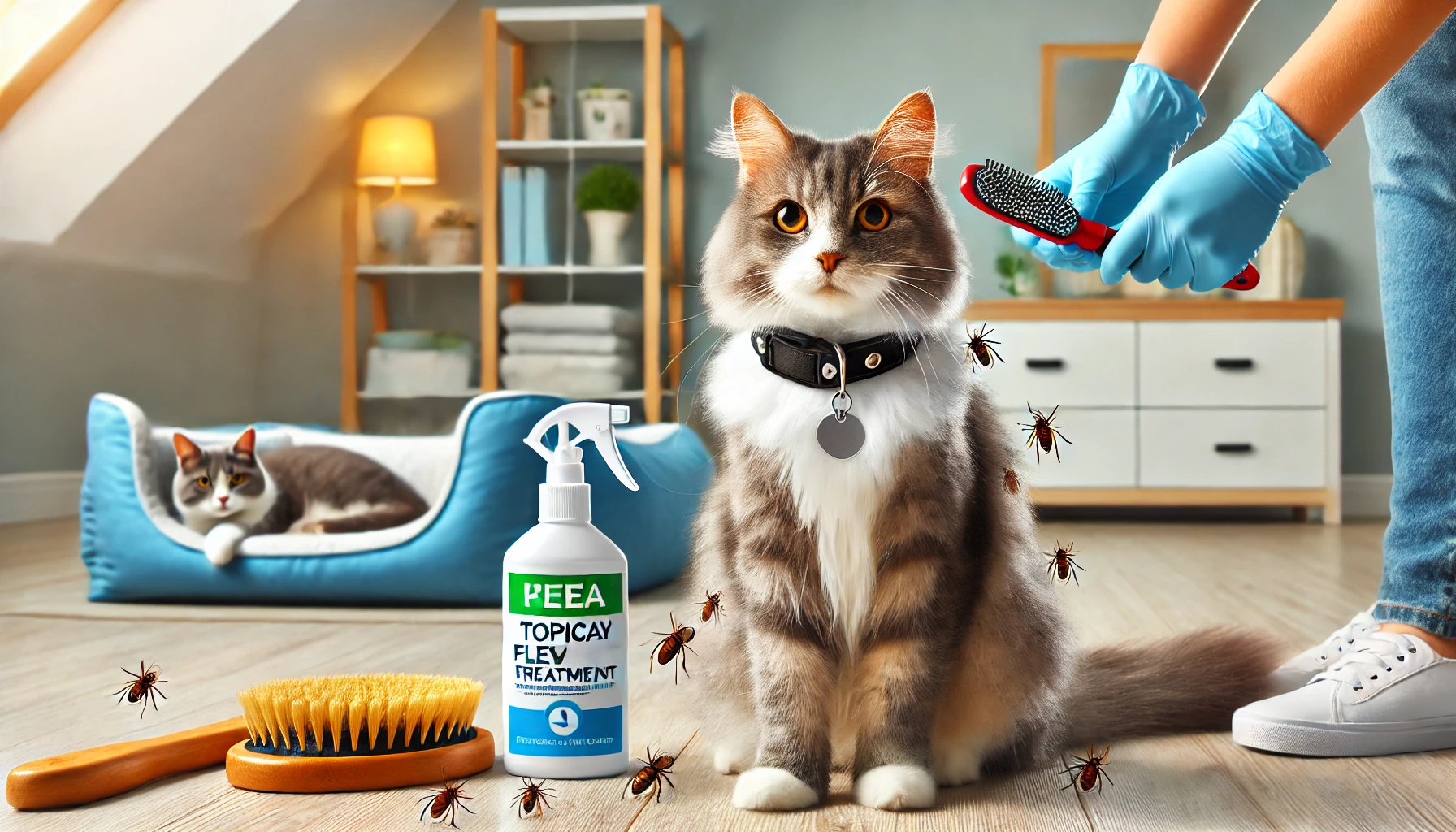
Effective Ways to Prevent Fleas
Prevention is always better than treatment, and with the use of year-round flea prevention methods, you can prevent re-infestation and the recurrence of flea allergies.
Prevention includes using flea collars, topical treatments, and maintaining a clean environment to deter fleas.
- Regular grooming helps detect fleas early and reduces discomfort caused by fleas.
- Cleaning your cat’s bedding and vacuuming your home regularly will keep it free from fleas.
- Maintaining your yard for outdoor cats can significantly reduce the chances of bringing fleas into your home.
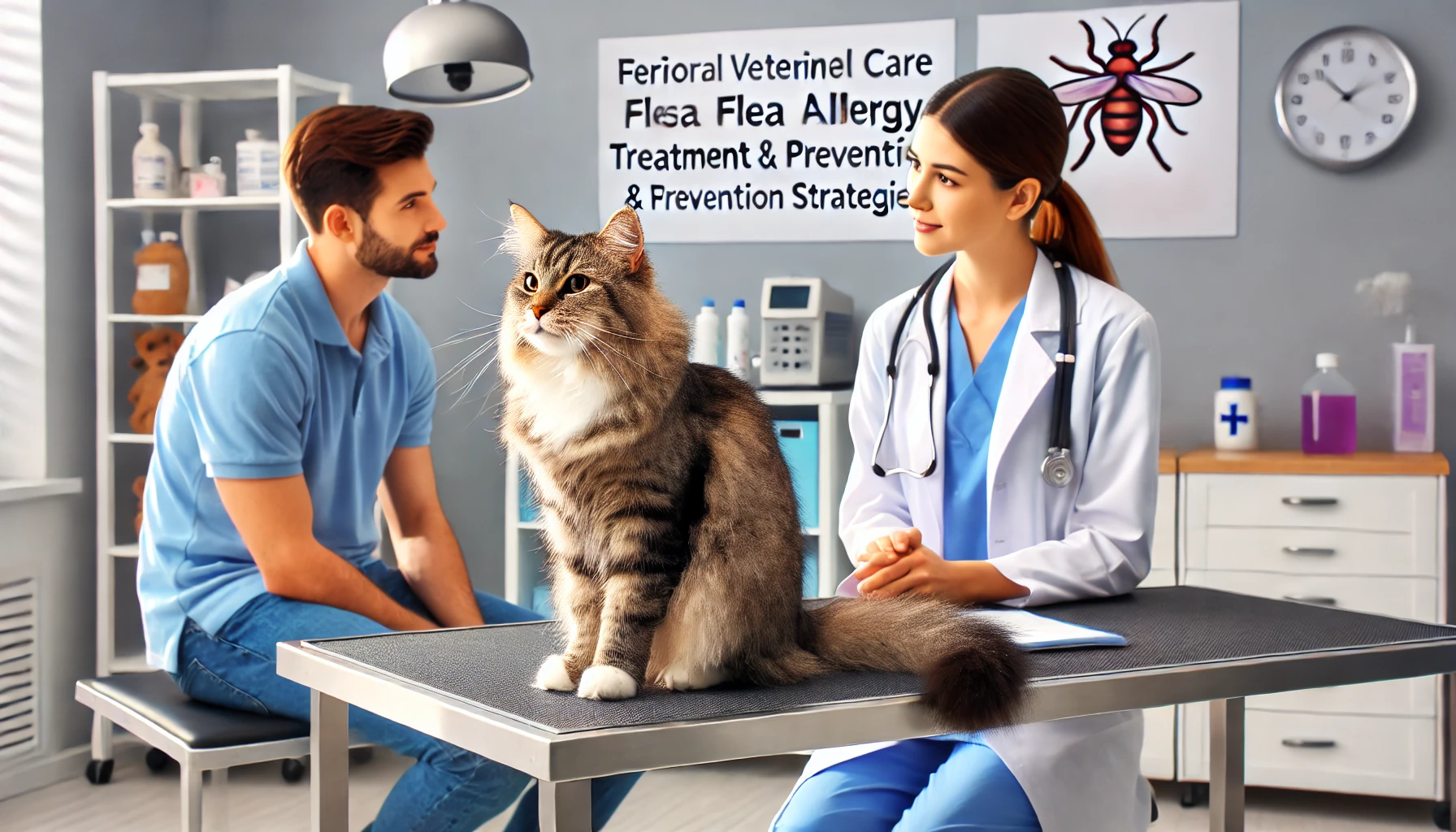
Consult Your Veterinarian for Tailored Care
Just as every cat is unique, the best flea prevention plan should be tailored to your cat’s specific needs, health, and lifestyle.
Always consult your veterinarian when selecting a treatment or prevention method to ensure it’s appropriate for your cat.
Monitoring for side effects is also an important part of keeping your cat healthy and safe during treatment.
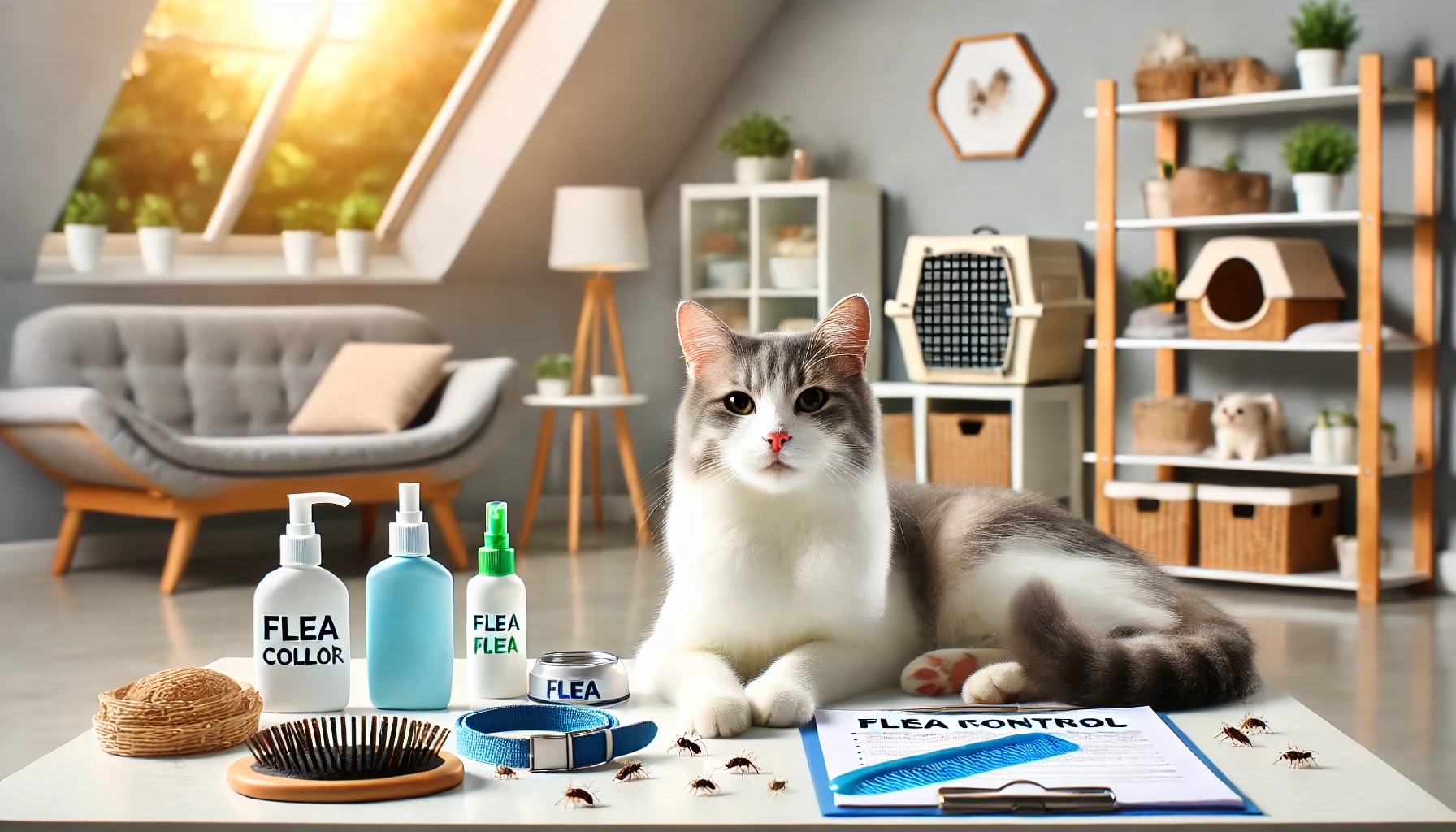
Final Thoughts on Flea Allergy Management
Managing flea allergies requires diligence, proper care, and ongoing prevention.
By taking proactive steps to protect your cat from fleas, you not only improve their comfort but also safeguard their health.
Fleas are a year-round issue, but with the right approach, you can keep your cat flea-free and happy for many years to come.
By addressing the root cause of flea allergies and using preventative measures, you can ensure your cat stays flea-free in the long run.
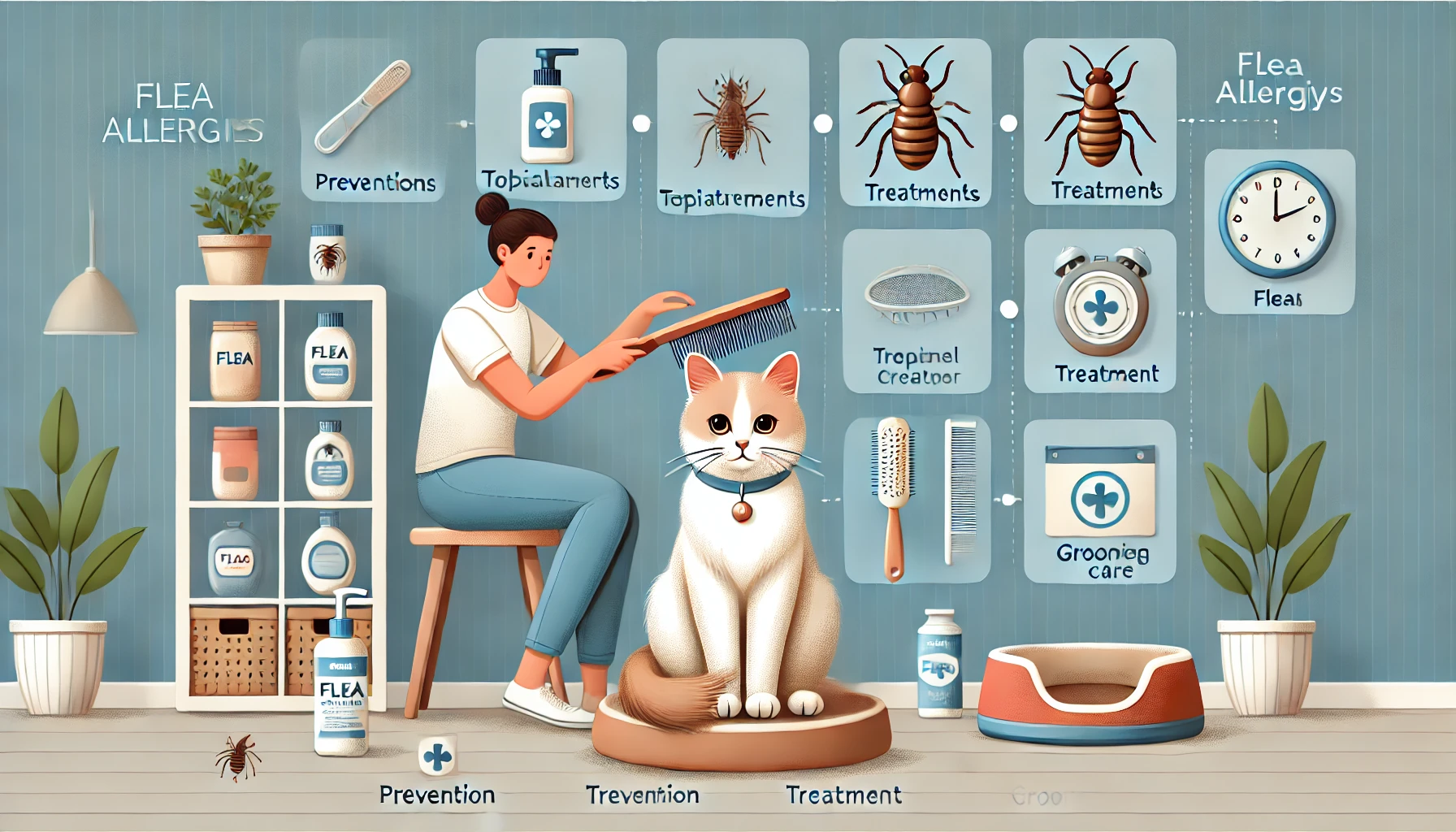
Frequently Asked Questions about Flea Allergies in Cats
Some common questions regarding the management and prevention of flea allergies in cats, helping you take better care of your feline friend by keeping them comfortable and healthy.
What are some common symptoms of flea allergies?
Symptoms include excessive scratching, red or inflamed skin, hair loss, scabs, and frequent grooming.
These signs are mostly seen around the neck, back, and tail regions where fleas typically bite.
How can I treat my cat's flea allergy?
Treating a flea allergy generally involves eliminating fleas with topical treatments, oral medications, or flea collars.
You can also treat the allergic reaction with antihistamines, steroids, and skin-soothing treatments to relieve discomfort.
Can indoor cats acquire flea allergies?
Yes, even indoor cats can develop flea allergies.
Fleas can enter your home on other pets or your clothing, and some cats can have an allergic reaction to just one flea bite.
How long does it take to clear a flea allergy in cats?
The time to clear a flea allergy depends on the extent of the infection and how well your cat responds to treatment.
Symptoms usually start subsiding within days of starting treatment.
What is the best flea prevention for cats with allergies?
The best flea prevention for cats with flea allergies involves regular use of veterinarian-approved topical treatments or oral medications, along with maintaining a clean environment to prevent re-infestation.
Can natural remedies be used for flea allergies?
Yes, natural remedies like oatmeal baths and aloe vera gel can help soothe irritated skin.
However, it is best to consult your veterinarian to ensure that relying solely on natural remedies will be effective in managing the flea allergies.
How often should I groom my cat if they suffer from flea allergies?
Grooming should be done regularly, especially using a flea comb to remove fleas and flea dirt.
This helps reduce discomfort and prevents further infestations or flare-ups.




